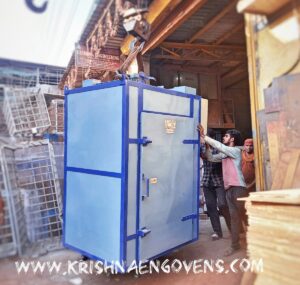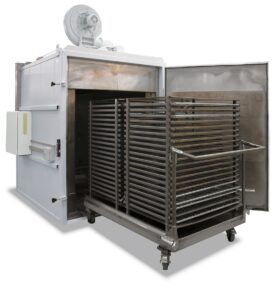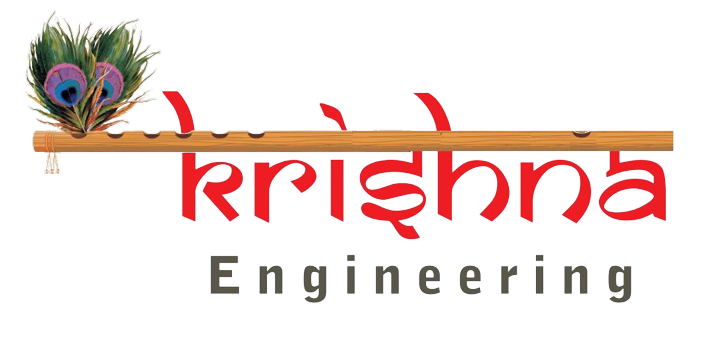What is Flux Baking Oven ?
Flux has multiple functions and takes on multiple forms during its performance of those functions. These forms occur at different stages of the brazing process as temperatures increase. In the first stage, which occurs at 212 degrees Fahrenheit, the water portion of the flux boils off.

Flux must possess a melting temperature lower than 1500°C so that the weld metal (WM) solidifies before the molten slag does.
A flux baking oven is a specialized piece of equipment used in industries such as welding, soldering, and brazing to heat-treat and remove moisture or other volatile substances from flux materials. Flux is a substance applied to metal surfaces to facilitate the soldering or brazing process by promoting the flow of molten metal and preventing oxidation.
Here are the key features and functions of a flux baking oven:
Temperature control: The oven is designed to reach and maintain specific temperature ranges suitable for baking flux materials. Typically, temperatures range from 100 to 250 degrees Celsius (212 to 482 degrees Fahrenheit). Precise temperature control is important to prevent overheating or under-baking of the flux.
Insulation: The oven is insulated to minimize heat loss and ensure energy efficiency during the baking process. Proper insulation helps maintain stable temperature conditions inside the oven and reduces the energy required for heating.
Heating elements: High-quality heating elements, such as electric resistance heating coils, are used to generate the required heat for baking the flux. These elements are designed to withstand the operating temperature range and provide uniform heating.
Air circulation: The oven incorporates an air circulation system, typically using fans or blowers, to ensure even distribution of heat throughout the oven. This helps accelerate the baking process and ensures uniform heat exposure for the flux materials.
Control panel: The oven is equipped with a control panel that allows operators to set and monitor the baking temperature, time, and other parameters. Some models may offer programmable controls for automated baking cycles.
Material handling: Depending on the size and design of the oven, it may include trays, racks, or hangers to hold and support the flux materials during the baking process. This ensures proper airflow around the flux and facilitates easy loading and unloading.
Exhaust system: If the baking process generates any fumes or volatile gases, the oven may feature an exhaust system to vent them safely. This helps maintain a clean working environment and ensures compliance with environmental regulations.
Safety features: Flux baking ovens may include safety features such as over-temperature protection, alarms, and safety interlocks to prevent overheating and ensure operator safety.
It’s important to note that the specific design and features of a flux baking oven may vary depending on the manufacturer, the size and capacity of the oven, and the specific requirements of the industry or application in which it is used.
Worldwide Exports Location:
Following Countries: Afghanistan, Albania, Algeria, Andorra, Angola, Antigua And Barbuda, Argentina, Armenia, Australia, Austria, Azerbaijan, Bahamas, Bahrain, Bangladesh, Barbados, Belarus, Belgium, Belize, Benin, Bhutan, Bolivia, Bosnia And Herzegovina, Botswana, Brazil, Brunei, Bulgaria, Burkina Faso, Burundi, Cabo Verde, Cambodia, Cameroon, Canada, Central African Republic (CAR), Chad, Chile, Colombia, Comoros, Democratic Republic Of The Congo, Republic Of The Congo, Costa Rica, Cote D’Ivoire, Croatia, Cuba, Cyprus, Czech Republic, Denmark, Djibouti, Dominica, Dominican Republic, Ecuador, Egypt, El Salvador, Equatorial Guinea, Eritrea, Estonia, Ethiopia, Fiji, Finland, France, Gabon, Gambia, Georgia, Germany, Ghana, Greece, Grenada, Guatemala, Guinea, Guinea-Bissau, Guyana, Haiti, Honduras, Hungary, Iceland, India, Indonesia, Iran, Iraq, Ireland, Israel, Italy, Jamaica, Japan, Jordan, Kazakhstan, Kenya, Kiribati, Kosovo, Kuwait, Kyrgyzstan, Laos, Latvia, Lebanon, Lesotho, Liberia, Libya, Liechtenstein, Lithuania, Luxembourg, Macedonia (FYROM), Madagascar, Malawi, Malaysia, Maldives, Mali, Malta, Marshall Islands, Mauritania, Mauritius, Mexico, Micronesia, Moldova, Monaco, Mongolia, Montenegro, Morocco, Mozambique, Myanmar (Burma), Namibia, Nauru, Nepal, Netherlands, New Zealand, Nicaragua, Niger, Nigeria, North Korea, Norway, Oman, Pakistan, Palau, Palestine, Panama, Papua New Guinea, Paraguay, Peru, Philippines, Poland, Portugal, Qatar, Romania, Russia, Rwanda, Saint Kitts And Nevis, Saint Lucia, Saint Vincent And The Grenadines, Samoa, San Marino, Sao Tome And Principe, Saudi Arabia, Senegal, Serbia, Seychelles, Sierra Leone, Singapore, Slovakia, Slovenia, Solomon Islands, Somalia, South Africa, South Korea, South Sudan, Spain, Sri Lanka, Sudan, Suriname, Swaziland, Sweden, Switzerland, Syria, Taiwan, Tajikistan, Tanzania, Thailand, Timor-Leste, Togo, Tonga, Trinidad And Tobago, Tunisia, Turkey, Turkmenistan, Tuvalu, Uganda, Ukraine, United Arab Emirates (UAE), United Kingdom (UK), United States Of America (USA), Uruguay, Uzbekistan, Vanuatu, Vatican City (Holy See), Venezuela, Vietnam, Yemen, Zambia, Zimbabwe.
India Location –
Maharashtra, Mumbai, Pune, Nagpur, Nashik, Virar, Palghar, Aurangabad, Bhiwandi, Thane, Amravati, Malegaon, Kolhapur, Nanded, Sangli ,Jalgaon, Akola, Latur, Ahmadnagar, Dhule, Ichalkaranji, Chandrapur, Parbhani, Jalna, Bhusawal, Navi Mumbai, Raigad, Panvel, Bangalore, Karnataka, Ahmedabad, Gujarat, Chennai, Tamil Nadu, Surat, Coimbatore, Vadodara, Indore, Madhya Pradesh, Bhubaneswar, Orissa, Hyderabad, Andhra Pradesh, Jamshedpur, Jharkhand, Kolkata, West Bengal ,Delhi, Jaipur, Rajasthan, Kochi, Kerala, Chandigarh, Punjab, Dehradun, Uttarakhand , Lucknow, Uttar Pradesh, Visakhapatnam, Andhra Pradesh, Guwahati, Assam, Amritsar, Mangalore, Noida, Gurgaon, Haryana, Bhopal, Madhya Pradesh, Aurangabad, Faridabad, Allahabad, Prayagraj, Jodhpur.




